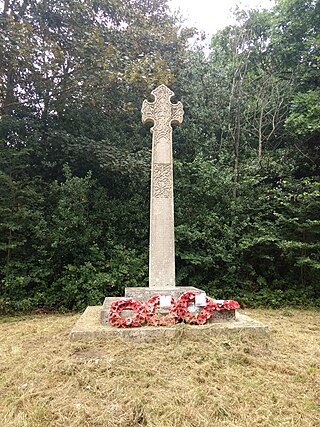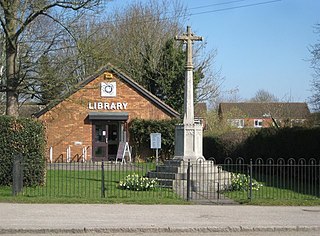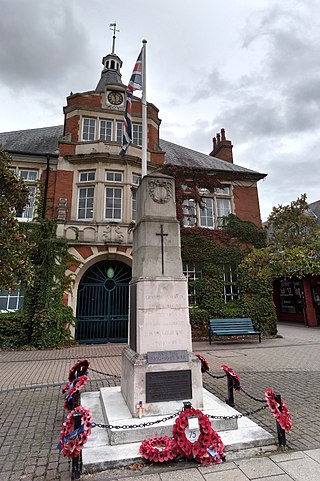Related Research Articles

The Willesden United Synagogue Cemetery, usually known as Willesden Jewish Cemetery, is a Jewish cemetery at Beaconsfield Road, Willesden, in the London Borough of Brent, England. It opened in 1873 on a 20-acre (0.08 km2) site. It has been described as the "Rolls-Royce" of London's Jewish cemeteries and is designated Grade II on Historic England's Register of Historic Parks and Gardens. The cemetery, which has 29,800 graves, has many significant memorials and monuments. Four of them are listed at Grade II. They include the tomb of Rosalind Franklin, who was a co-discoverer of the structure of DNA.

Naphhill Common is a 71.1-hectare (176-acre) Site of Special Scientific Interest in Naphill in Buckinghamshire. It is in of the Chilterns Area of Outstanding Natural Beauty, and it is listed in A Nature Conservation Review. It is common land, with commoners' rights to estovers, grazing and firebote.

The Quintin and Alice Hogg Memorial is a memorial for English philanthropist Quintin Hogg and his wife Alice stands on Portland Place in central London, opposite BBC Broadcasting House. The bronze memorial depicts Quintin Hogg with two boys, and stands on a plinth of Portland stone. It was designed by George Frampton and erected in 1906. The memorial also honours Hogg's wife, Alice, and those members of the Regent Street Polytechnic killed in World War I and World War II.

Potters Bar war memorial is located in St John's Churchyard in High Street, Potters Bar, England. The memorial was designed by the Arts and Crafts architect and designer C.F.A. Voysey and originally stood at the junction of Hatfield Road and The Causeway. It has been Grade II listed on the National Heritage List for England since it was moved to its present location in December 1973. Voysey's only other free standing war memorial, the Malvern Wells War Memorial, was erected in 1920 in Malvern Wells in Worcestershire.

The New Barnet War Memorial stands on a triangular plot at the junction of Station Road and Lyonsdown Road, New Barnet. It is grade II listed with Historic England.

The Monken Hadley War Memorial is located immediately to the north of Monken Hadley at the western end of Camlet Way in Monken Hadley Common. It commemorates the men of the district who died in the First and Second World Wars and is in the form of a tapered decorated column with a celtic cross at the top and the names of the dead shown on the shaft. It was unveiled by Francis Fremantle, Member of Parliament for St Albans, in December 1920. It became a Grade II listed building in April 2017.

The principal war memorial in Enfield Town is the cenotaph that stands in Chase Green Gardens and is a grade II listed monument with Historic England. It commemorates men lost in both the World Wars as does a plaque in the town's main post office. In addition, in 2003 a memorial to those lost in the Arctic campaign of the Second World War was unveiled.

Hornsey War Memorial is located in Park Road, Hornsey, in London, in front of the Hornsey Central Hospital, formerly the Hornsey Memorial Hospital.

The Wood Green War Memorial is located on the High Road, Wood Green, in the London Borough of Haringey. It was erected in 1920 and paid for by public subscription of the people of Wood Green to remember the men of the area who died during the First World War. It was subsequently adapted to include the dead of the Second World War. It is grade II listed with Historic England.

The Hampstead War Memorial is located in front of Heath House opposite Jack Straw's Castle, on the northern fringes of Hampstead Heath in London. The memorial marks the deaths of local individuals who died fighting in World War I and World War II. It was dedicated on 4 May 1922 by the Bishop of Willesden, William Perrin, in a ceremony attended by Major General Sir Charles Vere Ferrers Townshend. The memorial is a tall thin stone obelisk on a square plinth with a three-step base.

The Dulwich Old College War Memorial is located in the forecourt of Dulwich Old College on College Road in Dulwich in the London Borough of Southwark. It marks the deaths of the former pupils of the college who died in the First World War between 1914 and 1919. The memorial is made from Hopton Wood stone and was designed by William Douglas Caröe. It was unveiled in 1921. It has been grade II listed on the National Heritage List for England since May 2010. The heritage listing places the memorial within a "visual and contextual relationship" with the Grade II listed Old College building and the entrance gates and piers of the Old College, also Grade II listed.

The Dulwich College War Memorial is located at the eastern front of Dulwich College on College Road in Dulwich in the London Borough of Southwark. It commemorates the alumni of the college who died in both the First and Second World Wars. The memorial was designed by W. H. Atkin-Berry, an alumnus of the college. It was unveiled on 17 June 1921, the Dulwich College Founder's Day, by Major General Sir Webb Gillman, and dedicated by the Dean of Durham, James Welldon. Gillman was an alumnus of the college, and Welldon had served as Master of Dulwich College from 1883 to 1885. It has been Grade II listed on the National Heritage List for England since May 2010. The heritage listing places the memorial within a "visual and contextual relationship" with the Grade II* listed Main College building.

Aylesbury War Memorial is located in Market Square, Aylesbury, Buckinghamshire, England. It is a grade II listed building with Historic England.

Haddenham War Memorial is located in Church End, Haddenham, Buckinghamshire, England. It is a grade II listed building with Historic England. It was built in the summer of 1921 and unveiled by the Marquis of Lincolnshire on 16 October 1921. The memorial is built from Portland stone and stands 14 feet high. The apex of the obelisk is surmounted by a ball finial carved with acanthus (plant) leaves, between which are the thistle, shamrock and rose. The base has corner pilasters, framing the inscribed panels. On the North face of the obelisk is carved a laurel wreath, with the words ‘OUR GLORIOUS DEAD’ and ‘THEIR NAME LIVETH FOR EVERMORE’. On the plinth are the words: ‘IN/ HONOUR/ AND/ UNDYING MEMORY/ OF/ THE MEN OF THIS VILLAGE/ WHO/ GAVE THEIR LIVES/ IN THE GREAT WAR/ OF/ 1914- 1918/ AND/ 1939 -1945’. The names are then recorded, with the regiments to which the men belonged.
Hitcham War Memorial is located outside St Mary's Church, Hitcham Lane, Hitcham, Buckinghamshire, England. It is a grade II listed building with Historic England and commemorates men who died in the First and Second World Wars.

Radnage War Memorial is located at Mudds Bank, Radnage, Buckinghamshire, England. It is a grade II listed building with Historic England and commemorates the men of the village who died in the First and Second World Wars.

Stokenchurch War Memorial is located outside the Memorial Hall, Wycombe Road, Stokenchurch, Buckinghamshire, England. It is a grade II listed building with Historic England and commemorates the men of the village who died in the First and Second World Wars. It was built in 1925 alongside a memorial hall erected at the same time on land donated by Marcus Slade Q.C. It includes the names of two women who died during the Second World War, Eleanor Slade, a pilot in the Air Transport Auxiliary who died following a crash in 1944, and Florence Mary Steptoe a private in the Auxiliary Territorial Service who died in 1942.

Stoke and Wexham War Memorial is located in Wexham Street, Wexham, Buckinghamshire, England. It is a grade II listed building with Historic England and commemorates the men of the area who died in the First World War. It is in the form of a pavilion housing a pump that supplies a drinking fountain and horse trough. It was erected by Sir Bernard Oppenheimer (1866-1921).

Winslow War Memorial is located in High Street, Winslow, Buckinghamshire, England. It is a grade II listed building with Historic England and commemorates men who died in the First World War with later additions for the Second World War, Malayan Emergency and Falklands Conflict. It was unveiled in 1920.

New Malden War Memorial is a Grade II listed war memorial in the town of New Malden, Royal Borough of Kingston upon Thames, Greater London, England, commemorating local victims of the First and Second World Wars. Situated in the High Street of New Malden, in front of the erstwhile New Malden Town Hall now owned by Waitrose, New Malden War Memorial comprises a three-tiered cenotaph on a pedestal and two-stepped base.
References
- ↑ Naphill. Imperial War Museums. Retrieved 24 December 2017.
- ↑ Naphill War Memorial. War Memorials Online. Retrieved 24 December 2017.
- ↑ Historic England. "Naphill War Memorial (1445159)". National Heritage List for England . Retrieved 24 December 2017.
- ↑ 13 Bucks war memorials listed in 2017. Mix 96, 11 November 2017. Retrieved 24 December 2017.
Coordinates: 51°39′55″N0°46′37″W / 51.665199°N 0.776958°W